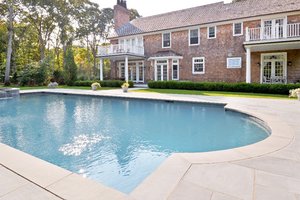
-
Home Upgrades with the Lowest ROI
 File these six upgrades under wish fulfillment, not value investment. Read
File these six upgrades under wish fulfillment, not value investment. ReadLife is a balancing act, and upgrading your home is no different. Some upgrades, like a kitchen remodel or an additional bathroom, typically add value to your home. Others, like putting in a pool, provide little dollar return on your investment.
Of course, home owning isn’t just about building wealth; it’s also about living well and making memories — even if that means outclassing your neighborhood or turning off future buyers. So if any of these six upgrades is something you can’t be dissuaded from, enjoy! We won’t judge. But go in with your eyes wide open. Here’s why:
1. Outdoor Kitchen
The fantasy: You’re the man — grilling steaks, blending margaritas, and washing highball glasses without ever leaving your pimped-out patio kitchen.
The reality: For what it costs — on average $12,000-$15,000 — are you really gonna use it? Despite our penchant for eating alfresco, families spend most leisure time in front of some screen and almost no leisure time outdoors, no matter how much they spend on amenities, according to UCLA’s Life At Home study. And the National Association of Home Builders’ 2013 What Home Buyers Really Want report says 35% of mid-range buyers don’t want an outdoor kitchen.
The bottom-line: Instead, buy a tricked out gas grill, which will do just fine when you need to char something. If you’re dying for an outdoor upgrade, install exterior lighting — only 1% of buyers don’t want that.
Related: How to Buy a Gas Grill
2. In-Ground Swimming Pool
The fantasy: Floating aimlessly, sipping umbrella drinks, staying cool in the dog days of summer.
The reality: Pools are money pits that you’ll spend $17,000-$45,000-plus to install (concrete), and thousands more to insure, secure, and maintain. Plus, you won’t use them as much as you think, and when you’re ready to sell, buyers will call your pool a maintenance pain.
The bottom-line: If your idea of making it includes a backyard swimming pool, go for it. But, get real about:
- How many days per year you’ll actually swim.
- How much your energy bills will climb to heat the water ($760-$1,845 depending on location and temperature).
- What you’ll pay to clean and chemically treat the pool ($20-$100/month in-season if you do it yourself; $75-$165/month for a pool service).
- The fact that you’ll likely need to invest in a pool fence. In fact, some insurance carriers require it.
Related:
Less expensive option: an above-ground pool
Lower maintenance option: natural pools
If you do put in a pool, you can save money by installing a solar heater.
3. In-Ground Spa
The fantasy: Soothing aching muscles and sipping chardonnay with friends while being surrounded by warm water and bubbles.
The reality: In-ground spas are nearly as expensive ($15,000-$20,000) as pools and cost about $1 a day for electricity and chemicals. You’ll have to buy a cover ($50-$400) to keep children, pets, and leaves out. And, like in-ground pools, in-ground spas’ ROI depends solely on how much the next homeowner wants one.
The bottom-line: Unless you have a chronic condition that requires hydrotherapy, you probably won’t use your spa as much as you imagine. A portable hot tub will give you the same benefits for as little as $1,000-$2,500, and you can take it with you when you move.
Related: What You Need to Know About Installing a Spa
4. Elevator
Your fantasy: No more climbing stairs for you or for your parents when they move in.
The reality: Elevators top the list of features buyers don’t want in the NAHB “What Buyers Really Want” report. They cost upwards of $25,000 to install, which requires sawing through floors, laying concrete, and crafting high-precision framing. And, at sales time, elevators can turn off some families, especially those with little kids who love to push buttons.
The bottom-line: If you truly need help climbing stairs, you can install a chair lift on a rail system ($1,000-$5,000). Best feature: It can be removed.
Related: 4 Easy-Living Tips for Aging in Place
5. Backup Power Generator
Your fantasy: The power in your area goes kaput, but not for you. You were smart enough to install a backup power generator. While the neighbors eat cold hot dogs by a flashlight beam, you’re poaching salmon in your oven and pumping out Red Hot Chili Peppers tunes.
The reality: Power outages may seem to go on forever, but they don’t. Fifty dollars worth of batteries can power portable lights, radios, and TVs; a car adaptor will charge your cell phones and iPods; and some dry ice will keep freezer food cold for at least a couple of days.
The bottom-line: If you live in areas where power shortages are the rule, not the exception, spend the money for reliable backup power: Your still-frozen steaks, home office fax, and refrigerated medicine will thank you. But if the power goes out rarely, then installing a standby generator is overkill.
Nationwide, homeowners recouped 67.5% on their average $11,742 investment in a backup generator — one of the lowest ROIs on the annual Cost vs. Value Report. If you need occasional emergency power, a gasoline-powered portable generator ($200-$650) probably will suffice.
Related: What I Learned About Portable Generators One Dark and Stormy Night
6. New Windows
The fantasy: Brand new windows that don’t stick, and slash energy bills.
The reality: A $10,000 vinyl window replacement project will recoup about 70% of your investment at resale, and if they’re Energy Star-qualified, they can save you around $300 in energy bills per year. So, plan to live in your house about another 10 years to recoup the cost of new windows.
The bottom-line: We get it — new windows are sturdy, pretty energy savers. But unless old window frames are thoroughly rotten, most windows can be repaired for a fraction of replacement costs. And if you spend about $1,000 to update insulation, caulking, and weather-stripping, you’ll save 10%-20% on your energy bill.
Related:
Find and Seal Air Leaks in Your Home
Window Film: An Inexpensive Way to Save Energy
No judgments! What’s your home upgrade indulgence?
Lisa Kaplan Gordon is an avid gardener, a member of the Fairfax County Master Gardeners Association, and a builder of luxury homes in McLean, Va. She’s been a Homes editor for Gannett News Service and has reviewed home improvement products for AOL. Follow Lisa on Google+.
Read more: http://www.houselogic.com/home-advice/home-improvement/home-upgrades-you-shouldnt-do/#ixzz35R7IeVKq
Follow us: @HouseLogic on Twitter | HouseLogic on FacebookRead more: http://www.houselogic.com/home-advice/home-improvement/home-upgrades-you-shouldnt-do/#ixzz35R6Xhhpy
Follow us: @HouseLogic on Twitter | HouseLogic on Facebook
Visit houselogic.com for more articles like this.
Copyright 2014 NATIONAL ASSOCIATION OF REALTORS®
Read more: http//members.houselogic.com/download/web/#ixzz35R34W0bC
Follow us: @HouseLogic on Twitter | HouseLogic on Facebook

